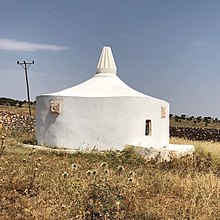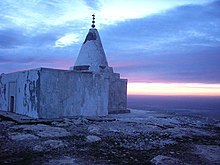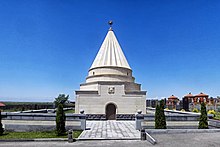Ezidikhan
Ezidikhan (other spellings: Ezidkhan or Ezdikhan , Kurmanji Êzîdxan even Êzdîxan or Êzîdîxan , Arabic ايزيدخان, German "Land of the Yazidis") describes the original settlement areas of the Yazidis . The settlement areas of the Yazidis are not contiguous.

etymology
Ezidikhan or Kurmanji “Ezidxan” is made up of the two words “Ezidy” (the Yazidis' own name) and Xan or Khan (English: house) and literally means the “house of the Yazidis”. It is also translated as the “Land of the Yazidis”. Furthermore, the term “Ezidxan” describes the community of the Yazidis.
Settlement areas
The term “Ezidxan” is also the name of traditional and historical settlement areas of the Yazidis. The original main settlement areas of the Yazidis are in northern Mesopotamia , in today's northern Iraq , in northern Syria and in southeastern Turkey .
Iraq
Among the residential areas of the Yazidis in Iraq in include district Sinjar the Iraqi town of Sinjar , the Yezidi villages north of Sinjar Mountains in the sub-district al-Schemal (the north) such. B. al-Tam'eem (Xanasor), Hiteen (Dugurê), Qadisīyāh (Dohula), al-Yarmoūk (Borêk), al-ʿAndalūs (Gohbal), al-ʿArobā (Zorava), Sinūnī (Sinunê), Hardan etc. , as well as Yazidi villages south of the Jebel Sinjar such as B. al-Qaḥṭānīya (Til Ezer), al-Jazīrāh (Sîba Şêx Xidir), al-ʿAdnānīya (Gir Zerk), al-Baath (Tel Qasab), al-Waleed (Tel Benat), Kocho etc. Im al-Hamdaniya District, Yazidis live in the cities of Baschiqa and Bahzani . Other Yazidi settlement areas are the city of Ain Sifni (Şêxan), Baadre , Mahad etc., as well as the holy place of the Yazidis Lalisch in the Shekhan district . In the Tel Kaif district , the Yazidis live in the villages of Bozan , Beban , Babira , Khatare , Dokhata , Sreshka , Khawshaba , etc. All of these towns and villages are located in the Iraqi province of Ninawa and are among the disputed areas in northern Iraq . Other Yazidi villages such as Khanke and Sharya are located in the Semile district in Dahuk Province . Yazidis of the Haweri tribe live in the small Iraqi town of Derabun in the Zaxo district in Dahuk province and in the surrounding area .
The Yazidi villages in Iraq are mostly so-called "model villages" which are also called muǧammaʿāt . For the settlement of the Yazidis, other Yazidi villages were depopulated by the Iraqi government in the 1960s to 1980s, and the newly established Yazidi villages were renamed to Arabic names as a result of the Arabization policy of the Baath party . The approximately 400 Yazidi villages of Jebel Sinjar were razed to the ground and the inhabitants were forced to resettle. Some villages were not destroyed in order to resettle Arab tribes. The Ba'ath regime called these forced resettlement measures modernization projects. The same fate happened to the Yazidis in the Shaikhan area. An example of the action of the Iraqi government at that time is the originally Yazidi city of Ain Sifni (Shekhan), the Yazidi population was partly driven out of the city and deported to the newly built village for the Yazidi Mahad . In return, Kurds and Arabs were settled in Ain Sifni (Shekhan).
Turkey
The Yazidis in Turkey lived mainly in Southeast Anatolia , especially in the Tur Abdin mountain range , in the villages of Oyuklu (Taqa), Çayırlı (Kefnas), Güven (Bacin), Çörekli (Denwan), Yenice (Xerabya), Koçan , etc. in the district Midyat and in Kaleli (EFSE), Değirmencik (Qolika) Çilesiz (Mezre) Güneli (Geliyê Sora), Mağaracık (Xanik), etc. in the district of Nusaybin in Mardin province and in Mağara (Kiwex), etc. in the district İdil in Şırnak Province . More Yezidi villages in Turkey are Yolveren (Çinerya) in the district of Batman and Yolkonak (Hacrê) Üçkuyular (Feqiran) Kuşçukuru (Kelhok) Uğurca (Qorikh), Oğuz (Şimiz) Kurukavak (Hamduna) Kumgeçit (Bazîvan) Deveboynu (Geduk) Onbaşı (Şahsîm) Meydancık (Duşa) Uğrak (Texerî), etc. in the district Beşiri in the province of Batman . The Yezidi village of Bahçecik is located in the province of Diyarbakır in the district of Sur , in the district of Bismil is the Yazidi village of Yasince and in the district of Çınar is the Yazidi village of Gürses (Davudi). The Yezidi villages Burç , Işıklı (Zevra), Bozca (Xirbe Belek), Üçgül (Minminik), Oğlakçı etc. are located in the district of Viranşehir in the province of Şanlıurfa . Other former Yezidi settlement areas are in the province of Siirt . The Yazidi villages were renamed through the Turkishization of geographical names in Turkey . In Viranşehir County, Yazidi parents had to take their children from the school in Viranşehir because they were forced to offer Muslim prayers there. In general, Yazidis are exposed to severe discrimination in Turkey and usually have to keep their identity secret. Their property and houses are expropriated and they are replaced by new owners from the land register. In May 1989, the then Interior Minister of North Rhine-Westphalia, Herbert Schnoor , traveled to the Yazidi settlement areas in Turkey to see for himself. Schnoor campaigned for the right to stay for the Yazidis living in Germany. Around 2000 Yazidis live in Turkey today, who were originally born there or who have returned to their original villages from Germany. In the 1980s there were around 60,000 Yazidis living in Turkey. Almost all Yazidis from Turkey have fled their former villages and towns because they were oppressed and driven out by the Kurds and Turks. Most of the Yazidis who are originally from Turkey currently live in Germany, Armenia and Georgia. Some of them also fled to Sinjar in Iraq. The larger cities such as Mardin, Batman, Viranşehir etc. are predominantly inhabited by Kurds. The small Yazidi villages were largely uninhabited after the Yazidis were expelled from Turkey and were considered to be extinct. After the mass exodus of the Yazidis from Sinjar in 2014, many Yazidis from Iraq temporarily fled to the extinct Yazidi villages in Turkey. Some Yazidis, who originally come from Turkey and currently live in Germany, try to return to their former villages, but they are threatened and prevented from doing so by paramilitary groups (“ village guards ”).

Syria
The settlement areas of the Yazidis in Syria include the surrounding villages around the city of Afrin such as B. al-Sūq al-Kabīr (Gundê Mezin) and Raʾs al-Aswad (Feqîra) etc. The city of Afrin itself is predominantly inhabited by Kurds. Many Yazidis also live in Afrin. Around 20,000 Yazidis are said to live in several dozen villages around the Afrin region in Syria. The exact number of Yazidis in Syria and their villages is not known. Some estimates assume 21 villages, others 23 villages, and others 26 Yazidis villages in the Afrin region. The second largest settlement area of the Yazidis in Syria is located in the al-Hasakah governorate in the Jazīra region in northeast Syria. In the vicinity of al-Qahtaniyya (Tirbespi) there are Yazidi villages such as B. al-Marj (Dreçik) and al-Thalja (Otelja) etc. In the vicinity of Amude there are Yazidi villages such. B. Saradīq (Qizlaçuk) and al-Līd (Qolia) etc. To the north of al-Hasakah and near Raʾs al-ʿAin (Sere Kaniye) along the Khabur River there are numerous Yezidi villages. The Yazidi villages were almost completely destroyed and bombed by the civil war in Syria and the actions of the Islamic State , as well as the Turkish military offensive in Afrin . ISIS terrorists previously destroyed Yazidi temples and desecrated Yazidi graves. Presumably all Yazidis fled Syria if they were not killed.
Diaspora
Today, Yazidis have spread to other countries through emigration. Many Yazidis live in Europe (Germany, the Netherlands, Sweden, etc.) and the Caucasus (Armenia, Georgia and Russia). Over 35,000 Yazidis live in Armenia (2011) and over 200,000 Yazidis live in Germany (2017).
Aspirations for autonomy
There are efforts by the Yazidis in the Sinjar district to establish their own autonomy called “Ezidxan”. The Yazidis in the region feel disadvantaged by the Kurdish government and the Iraqi government. During the 2014 genocide of the Yazidis , the Yazidis were abandoned by the Kurdish Peshmerga .
history
In the 19th century there was an autonomous Yazidi principality in the Ottoman Empire , which was called "Ezidxan". The principality of Yezidxan was located around the village and the Redwan castle of the same name in the Garzan area (today north of Cizir in Turkey ). It was ruled by the Yazidi prince Seid Beg. Seid Beg defended the Yazidi principality and fought against the Kurdish prince Bedirxan Beg . Even before Seid Beg there was an autonomous Yazidi principality in this area, which was ruled by the Yazidi prince Mirza Axa (also Agha or Aga), who was constantly at war with other Kurdish princes.
Modern mention
In the Sinjar district , a Yazidi militia calls itself " Hêza Parastina Êzîdxan " (Ezidikhan's defense force) and controls the region there.
Personalities
In Yezidi history there were many Yazidi rulers and princes who ruled Yezidi-inhabited areas and are now honored by the Yazidis as national heroes. Here are some examples:
Individual evidence
- ↑ Şingal and IS: The jihadist genocide against the Yezidi and the consequences. LeEZA (League for Emancipatory Development Cooperation), August 1, 2016
- ↑ Artur Rodziewicz: Milete min Êzîd. The Uniqueness of the Yezidi Concept of the Nation . S. 73 ( academia.edu [accessed February 20, 2019]).
- ↑ Victoria Arakelova: Ethno-Religious Communities Identity markers . S. 3 ( academia.edu [accessed February 20, 2019]).
- ↑ a b Lokman Turgut: Oral literature of the Kurds in the Botan and Hekarî regions . Logos Verlag Berlin GmbH, 2011, ISBN 978-3-8325-2727-3 , p. 160, 161 ( limited preview in Google Book Search [accessed December 31, 2017]).
- ^ Emerging Land Tenure Issues among Displaced Yazidis from Sinjar, Iraq. (PDF) In: United Nations Human Settlements Program (UN – Habitat). November 2015, accessed December 24, 2018 .
- ↑ BVwG L507 2123711-1 - Finding (full text): RDB legal database. Retrieved January 28, 2019 .
- ↑ Saadi Azuo, Heerish: Graduate school of social sciences general psychology master's program: Post-traumatic stress disorder among Ezidian women who escaped from ISIS capture. (PDF) In: Near East University. June 2016, accessed December 24, 2018 .
- ^ The Struggle to Exist - Part I: An Introduction to the Assyrians and their Human Rights Situation in the New Iraq. (PDF) In: Assyria Council of Europe, Hammurabi Human Rights Organization. February 2010, accessed December 24, 2018 .
- ^ Otmar Oehring: CHRISTIANS AND YAZIDIS IN IRAQ: CURRENT SITUATION AND PROSPECTS. (PDF; 6.5 MB) In: Konrad-Adenauer-Stiftung . P. 93 , accessed on February 18, 2019 (English).
- ↑ Irene Dulz: The Yezidis in Iraq: between "model village" and escape . LIT Verlag Münster, 2001, ISBN 978-3-8258-5704-2 ( google.de [accessed on January 3, 2019]).
- ↑ Lower Saxony OVG, judgment of July 17, 2007 - 11 LB 332/03 - openJur. Retrieved January 2, 2019 .
- ↑ Ersoy Soydan: BATMAN YEZIDIS AND YEZIDIS ORAL TRADITION (BATMAN YEZİDİLERİ VE YEZİDİ SÖZLÜ KÜLTÜRÜ) . ( academia.edu [accessed December 15, 2018]).
- ^ Anatolic index. Retrieved December 20, 2018 .
- ↑ İHD'den Ezidi Raporu. Retrieved December 24, 2018 (Turkish).
- ↑ TMMOB Mimarlar Odası Diyarbakır Şubesi. Retrieved December 24, 2018 .
- ↑ İNSAN HAKLARI BATMAN PLATFORMUNUN BATMAN'DAKİ SIĞINMACI VE MÜLTECİLERE İLİŞKİN GÖZLEM VE TESPİT RAPORU. (PDF) March 3, 2015, accessed January 2, 2019 (Turkish).
- ↑ Dr. Ahmet Turan: Yezidiler. (PDF) Retrieved September 3, 2019 (Turkish).
- ↑ Esma Çakir-Ceylan: Violence in the Name of Honor: an investigation into acts of violence in Germany and Turkey with special consideration of the legal development in Turkey . Peter Lang, 2011, ISBN 978-3-631-61356-6 ( google.de [accessed on January 11, 2019]).
- ^ Yazidis in Turkey on the verge of extinction. Accessed February 2, 2019 .
- ↑ Yvonne Bangert: Three crosses in the pass is called Yezide. (PDF) Retrieved January 2, 2019 .
- ↑ Return of Yazidis to Turkey. (PDF) In: Federal Office for Recognition of Foreign Refugees . July 30, 2004, accessed January 2, 2019 .
- ↑ Birgül Açikyildiz: The Yezidis: The History of a Community, Culture and Religion . IBTauris, 2014, ISBN 978-0-85772-061-0 ( google.de [accessed on January 4, 2019]).
- ^ Deutsche Welle (www.dw.com): Yazidi refugees in Turkey | DW | 09/18/2014. Accessed January 2, 2019 (German).
- ↑ Ulla Jelpke , Christine Buchholz , Annette Groth a . a .: Situation of members of the Yazidi religious community. (PDF) In: German Bundestag . June 12, 2014, p. 2 , accessed February 12, 2019 .
- ↑ Kirsten Ripper: Afrin offensive of Turkey: Yazidis feel acutely threatened. March 20, 2018, accessed December 15, 2018 .
- ↑ Yazidis as victims of Turkish attacks on Afrin? - derStandard.at. Retrieved December 15, 2018 (Austrian German).
- ^ Erdoğan's Islamist ground troops in Syria. January 28, 2018, accessed December 15, 2018 .
- ↑ Sebastian Maisel: Yezidis in Syria: Identity building among a Double Minority . Lexington Books, 2016, ISBN 978-0-7391-7775-4 ( google.de [accessed December 15, 2018]).
- ^ Sylvain Mercadier: Turkey's Afrin operation stokes Yazidi fears and fuels displacement. Accessed January 2, 2019 .
- ↑ Census of October 12-21 , 2011 in Armenia. (PDF) National Statistical Service of the Republic of Armenia, 2011, accessed December 15, 2018 (Armenian).
- ^ Foundation of a federal association - Yazidis in Germany organize. Retrieved January 29, 2019 (German).
- ↑ Gohdar Alkaidy: Mir Tahsin Said Beg: Head of the Yazidis dies in German exile . January 28, 2019 ( welt.de [accessed January 29, 2019]).
- ↑ Federal Agency for Civic Education: Is there a threat of the destruction of ethnic and religious diversity in Iraq? | bpb mobil. Accessed December 31, 2017 .
- ↑ Ferhad Ibrahim: Is there a threat of a destruction of the ethnic and religious diversity in Iraq? (PDF) In: From Politics and Contemporary History. Federal Agency for Civic Education , February 28, 2011, accessed on December 31, 2017 .
- ^ Deutsche Welle (www.dw.com): Yazidis: "They have let us down" | DW | 08/08/2015. Retrieved on February 22, 2019 (German).
- ↑ Sinan Gündoğar: Kürt Masalları . Evrensel Basım Yayın, 2015, ISBN 978-6-05331268-0 ( google.de [accessed on January 2, 2018]).
- ^ The Biblical Repository and Classical Review . JM Sherwood., 1842 ( google.de [accessed January 14, 2018]).
- ↑ Bela Bates Edwards, Absalom Peters, John Holmes Agnew, Selah Burr Treat: The American Biblical Repository . 1842 ( google.de [accessed on January 14, 2018]).
- ↑ Barzani's defeat in Sindschar - derStandard.at. Retrieved February 20, 2019 (Austrian German).



